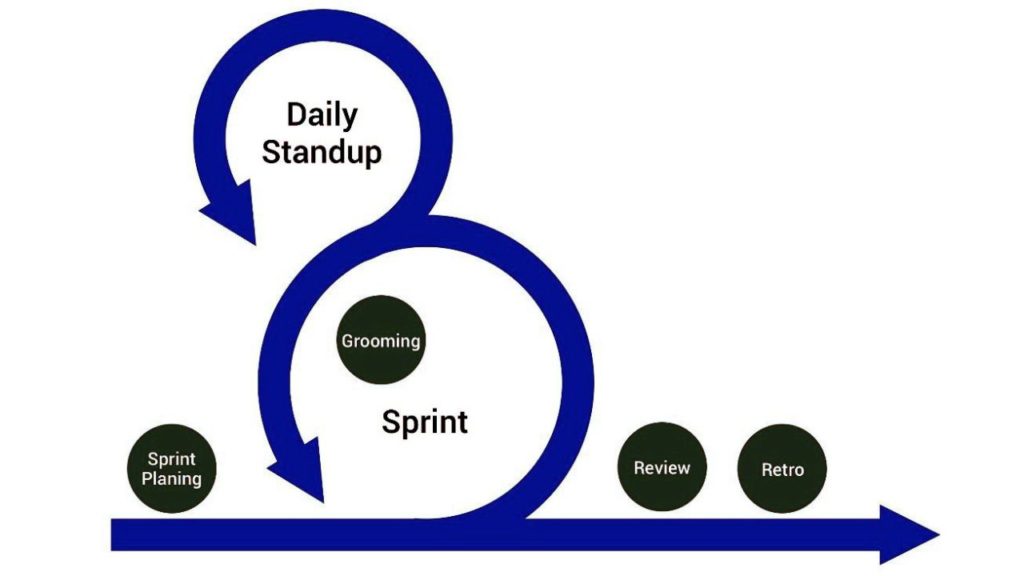Scrum’s Purpose and Best Practices
Introduction to Scrum’s Purpose and Best Practices
Welcome to our blog post on the fascinating world of Scrum, where we explore Scrum’s Purpose and Best Practices! If you’re eager to delve into the core principles and proven methods that drive agile success, you’re in the right place.
If you’re eager to explore the purpose, principles, and practices of Scrum in agile development, you’re in the right place. Before we dive into the nitty-gritty details, we’d like to invite you to enhance your understanding further by tuning in to our latest podcast episode on this very topic.
In this episode, we’ll be joined by industry experts who will share their insights and experiences with Scrum. You’ll gain valuable perspectives and real-world examples that complement the content of this blog post.
🎧 Listen to the Podcast Episode on Scrum:
Now, let’s embark on a journey to uncover the essence of Scrum, starting with its fundamental purpose.
The Purpose of Scrum
Scrum is more than just a buzzword in the world of software development—it’s a powerful framework designed to bring structure and agility to projects. In this section, we’ll explore the core purpose of Scrum and why it’s essential in modern development practices.
Defining Scrum’s Purpose
The Scrum is an agile framework created to help teams collaborate effectively and deliver valuable products. Its primary purpose is to facilitate the development of high-quality, adaptable products.
Scrum is designed to accommodate changing requirements and market dynamics gracefully. Its iterative and incremental approach allows teams to pivot and adjust course as needed, ensuring that the product remains aligned with customer needs.
Collaboration is a cornerstone of Scrum. Scrum fosters collaboration among cross-functional teams, breaking down silos and promoting open communication.
Scrum is all about delivering value to customers and stakeholders. Scrum accomplishes this by prioritizing work based on its potential value and ensuring that the most valuable features are delivered first, and product increments are produced in short cycles, allowing for quicker value delivery.
Understanding the Scrum Guide
The Scrum Guide is the definitive source for understanding Scrum’s principles and practices. In this section, we’ll take a detailed look at the Scrum Guide and its crucial role in guiding Scrum practices.
What is the Scrum Guide?
The Scrum Guide is—an authoritative document written by the creators of Scrum, Ken Schwaber and Jeff Sutherland. It serves as the official reference for understanding Scrum and provides a common framework for Scrum practitioners.
Scrum Guide Components
The key components of the Scrum Guide are an overview of the roles (e.g., Scrum Master, Product Owner, Developers), events (e.g., Sprint, Daily Scrum, Sprint Review, and Sprint Retrospective), and artifacts (e.g., Product Backlog, Sprint Backlog) defined in the guide.
The Scrum Guide’s Role
The Scrum Guide is so important in Scrum adoption because it acts as a compass, providing guidance and standards for teams and organizations implementing Scrum. It helps ensure consistency and alignment in Scrum practices across different contexts.
Updates and Evolution
The Scrum Guide isn’t static; it evolves over time. The Scrum Guide has been updated in the past (Scrum Guide 2017. and Scrum Guide 2020) and I’ve created The Real Scrum Guide 2023 so that these updates reflect the evolving understanding of Scrum and its applicability.
The Scrum Guide isn’t just for beginners; it’s a valuable learning tool for Scrum Masters, Product Owners, and teams at all levels of experience. Scrum practitioners use the Scrum Guide to deepen their understanding and improve their Scrum implementations.
Resources for Accessing the Scrum Guide
Here you will find everything you need to know about the Official Scrum Guide, and The Real Scrum Guide 2023. [CLICK HERE]

When Scrum Doesn’t Fit?
While Scrum is a powerful framework, it’s not a one-size-fits-all solution. In this section, we’ll explore situations and contexts where Scrum may not be the best fit and discuss alternative approaches that might be more suitable.
First, Scrum is well-suited for complex and adaptive problems but may not be ideal for simpler, well-defined tasks. Explore how the Cynefin framework can help determine when Scrum is appropriate.
The Cynefin framework is a decision-making model that categorizes problems into different domains based on their complexity.
It helps determine when Scrum is appropriate by identifying whether a problem is complex (suitable for Scrum), complicated (benefiting from expert knowledge), simple (needing standard solutions), or chaotic (requiring immediate action).
Second, Long-term projects often pose challenges in Scrum due to their extended duration, making it harder to plan and manage work within short iterations. In such cases, traditional project management methodologies, with their emphasis on detailed planning, phase-based approaches, and extensive documentation, can provide a more structured and predictable framework for managing the complexities associated with long-term endeavors.
Next, Highly regulated industries like healthcare or finance often confront challenges with Scrum because of the need for rigorous compliance and documentation.
To address these challenges, organizations in such industries may opt to blend Scrum with other methodologies or frameworks, enabling them to maintain regulatory adherence while benefiting from Scrum’s agile practices.
And many others, like Geographically Dispersed Teams, Lack of Commitment to Agile Values, Hybrid Approaches…
Scrum Best Practices for Teams
High-performing Scrum teams share common practices that enable them to work effectively and deliver value consistently.
In this section, we’ll compile a list of best practices and tips for Scrum teams to maximize their effectiveness.
Cross-Functional Team Composition
Cross-functional teams with diverse skills and roles are vital in Scrum as they bring a broad spectrum of expertise to the table, enabling them to tackle a wide range of tasks and challenges effectively.
This approach promotes collaboration, reduces dependency on external resources, and enhances adaptability, ultimately leading to faster and more efficient product development. [CHECK THIS BLOG POST]
Clearly Defined Roles and Responsibilities
Clearly defined roles and responsibilities in Scrum, such as the Scrum Master facilitating the process, the Product Owner representing the customer’s needs, and the Development Team delivering the work, are essential for smooth collaboration.
This clarity fosters accountability, minimizes misunderstandings, and streamlines decision-making, ensuring that everyone in the team knows their role and contributes effectively to achieving project goals. [CHECK THIS BLOG POST]
Effective Sprint Planning
Effective Sprint Planning is a critical Scrum practice that ensures teams start each iteration with a clear purpose and direction.
During these meetings, teams set clear Sprint goals that align with business priorities and break down user stories or tasks, facilitating a shared understanding of what needs to be achieved and how it will be accomplished during the upcoming Sprint.
Daily Scrum (Daily Stand-up) Meetings
Daily Stand-up Meetings in Scrum serve as a brief but vital opportunity for team members to synchronize their efforts, share progress, and identify any obstacles in achieving Sprint goals.
To ensure productivity, team members should focus on their commitments, update others on their progress, and collaborate in real-time to address impediments, fostering a sense of transparency and collaboration within the team. [Daily Scrum Challenges]
Collaborative Retrospectives
Collaborative Retrospectives in Scrum provide a dedicated space for teams to reflect on their recent work, celebrate successes, and identify areas for improvement.
By conducting retrospectives with a focus on open communication, shared learning, and actionable feedback, teams can continuously enhance their processes, leading to more effective and efficient future Sprints. [Powerful Sprint Retro Secret that will take your Scrum team performance to the next level]
Prioritizing the Product Backlog
Prioritizing the Product Backlog in Scrum involves strategically arranging items to maximize value delivery.
By aligning the backlog with customer needs and business goals, teams can ensure that the most valuable features are addressed first, optimizing product development and customer satisfaction. [What is a Product Backlog in Scrum + FREE Product Backlog Template?]
Embracing Agile Mindset
Embracing the Agile mindset is crucial in Scrum as it promotes a culture of adaptability, collaboration, and continuous improvement.
This mindset encourages teams to respond to change, deliver customer value iteratively, and foster open communication, ultimately leading to better results and increased customer satisfaction. [Your Baby Steps with Scrum: How to start with Scrum?]
Continuous Learning and Adaptation
Continuous learning and adaptation in Scrum involve the ongoing improvement of processes and practices based on empirical data and past experiences.
Teams that leverage tools and techniques to track progress, gather feedback, and make data-driven decisions can refine their approach, enhance productivity, and deliver greater value in each Sprint.
Avoiding Common Pitfalls
Avoiding common pitfalls in Scrum is essential to maintaining efficiency and achieving successful project outcomes.
By being vigilant against issues like scope creep, over-commitment, and neglecting the Definition of Done, teams can ensure that they adhere to Scrum principles and deliver high-quality, value-driven results. [The Business Imperative of Scrum, Igniting Success and Avoiding Pitfalls]
Collaboration and Communication
Collaboration and communication are the lifeblood of successful Scrum teams, facilitating the exchange of ideas and information for informed decision-making.
Establishing effective communication channels, fostering a culture of transparency, and maintaining robust feedback loops not only enhance teamwork but also ensure that stakeholders are aligned with project progress and goals.
How to Become a Scrum Master or Product Owner with No Experience?
Starting a career as a Scrum Master or Product Owner is an achievable goal, even if you have no prior experience in these roles. In the video below, I’ll provide guidance and insights to help you kickstart your journey.
Conclusion
In this blog post, we’ve embarked on a journey through the fascinating world of Scrum, exploring Scrum’s Purpose and Best Practices—an agile framework that has revolutionized the way teams collaborate and deliver value in the realm of software development.
The Scrum isn’t just a set of practices; it’s a mindset that empowers teams to adapt, collaborate, and deliver value efficiently. I would like to highlight its flexibility and its ability to accommodate a wide range of project types and industries.
A Framework for Success
Scrum is not just a buzzword but a proven framework for success, offering a comprehensive approach to Scrum’s Purpose and Best Practices. It equips teams and organizations with the tools and principles needed to thrive in today’s fast-paced and ever-changing business landscape.
The Journey Continues
I encourage you to continue your exploration of Scrum, whether you’re a beginner seeking to understand the basics or an experienced practitioner looking to deepen your knowledge.
Learning and improvement are ongoing processes in the world of Scrum.
So how to do this:
- Read this Scrum Blog
- ENROLL TO FREE COURSE
- Join the vibrant Scrum community and participate in the discussion.
Get Started
Finally, I encourage you to take action and explore Scrum’s Purpose and Best Practices. Whether you are already part of a Scrum team, considering a career change, or are simply curious about Scrum, I urge you to put your newfound knowledge into practice and delve deeper into the world of Scrum.
Free Scrum Learning Resources
Please visit the URL provided earlier to access free Scrum learning resources, making it easy for you to take the next step in your Scrum journey.
In closing, Scrum’s Purpose and Best Practices are not just a framework; they’re a transformative approach that empowers individuals, teams, and organizations to excel in the world of agile development.
Whether you’re just starting or have years of experience, Scrum offers a path to continuous improvement, collaboration, and value delivery. Embrace Scrum, embark on your agile journey, and witness the positive impact it can have on your projects and career.
Thank you for joining us on this exploration of Scrum, and we look forward to accompanying you on your exciting Scrum journey ahead.
